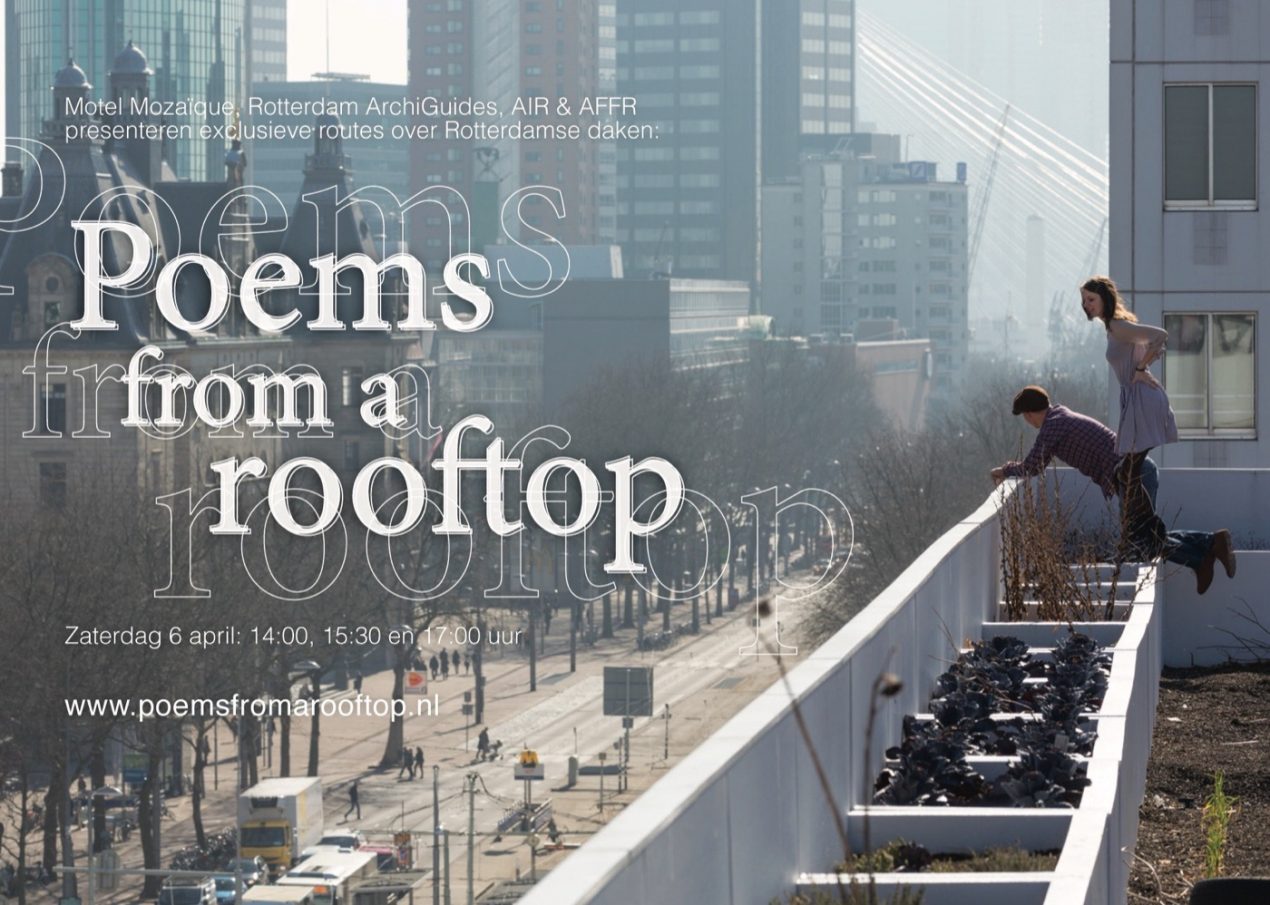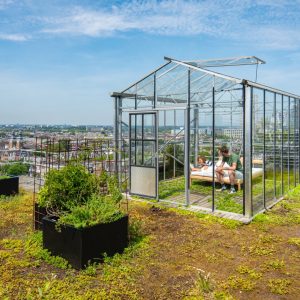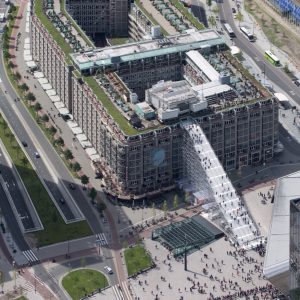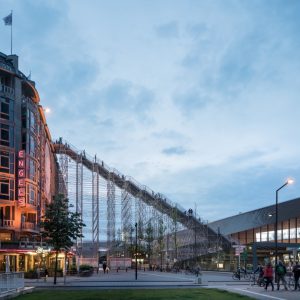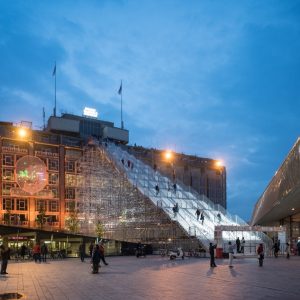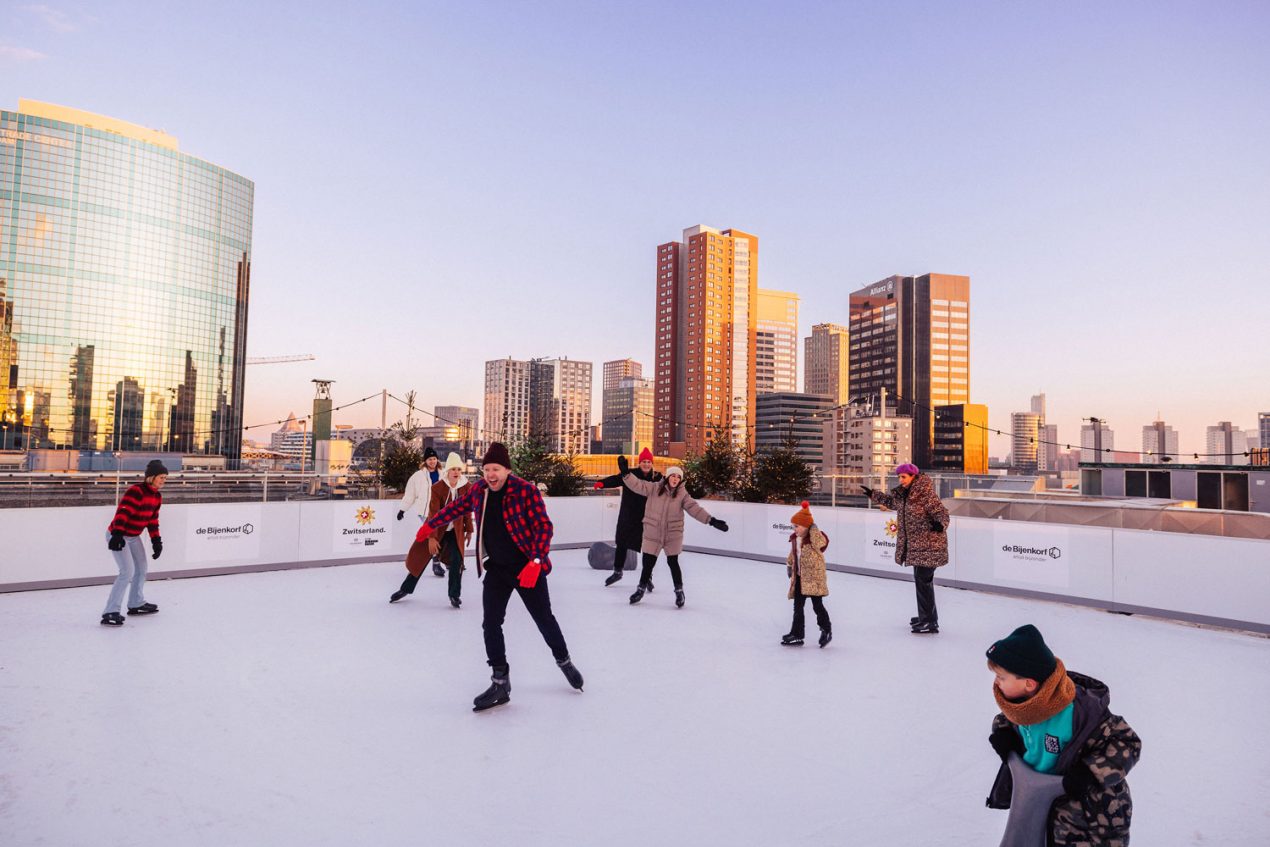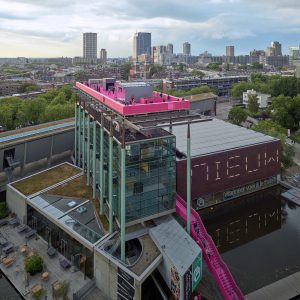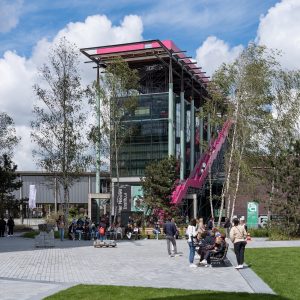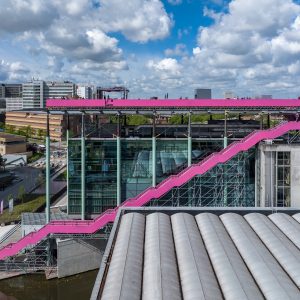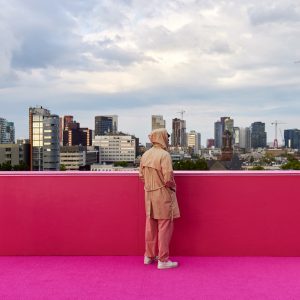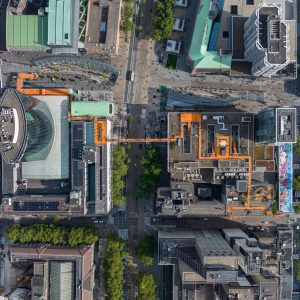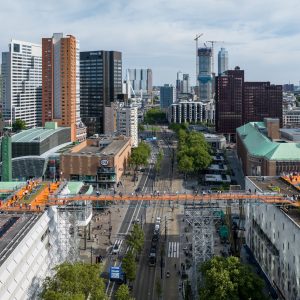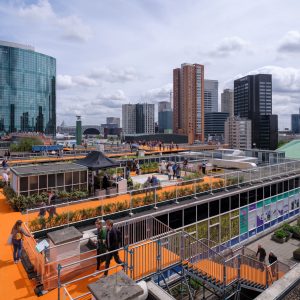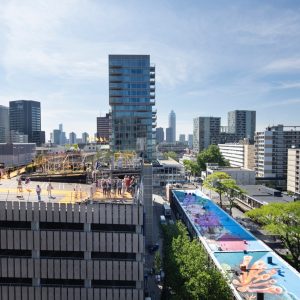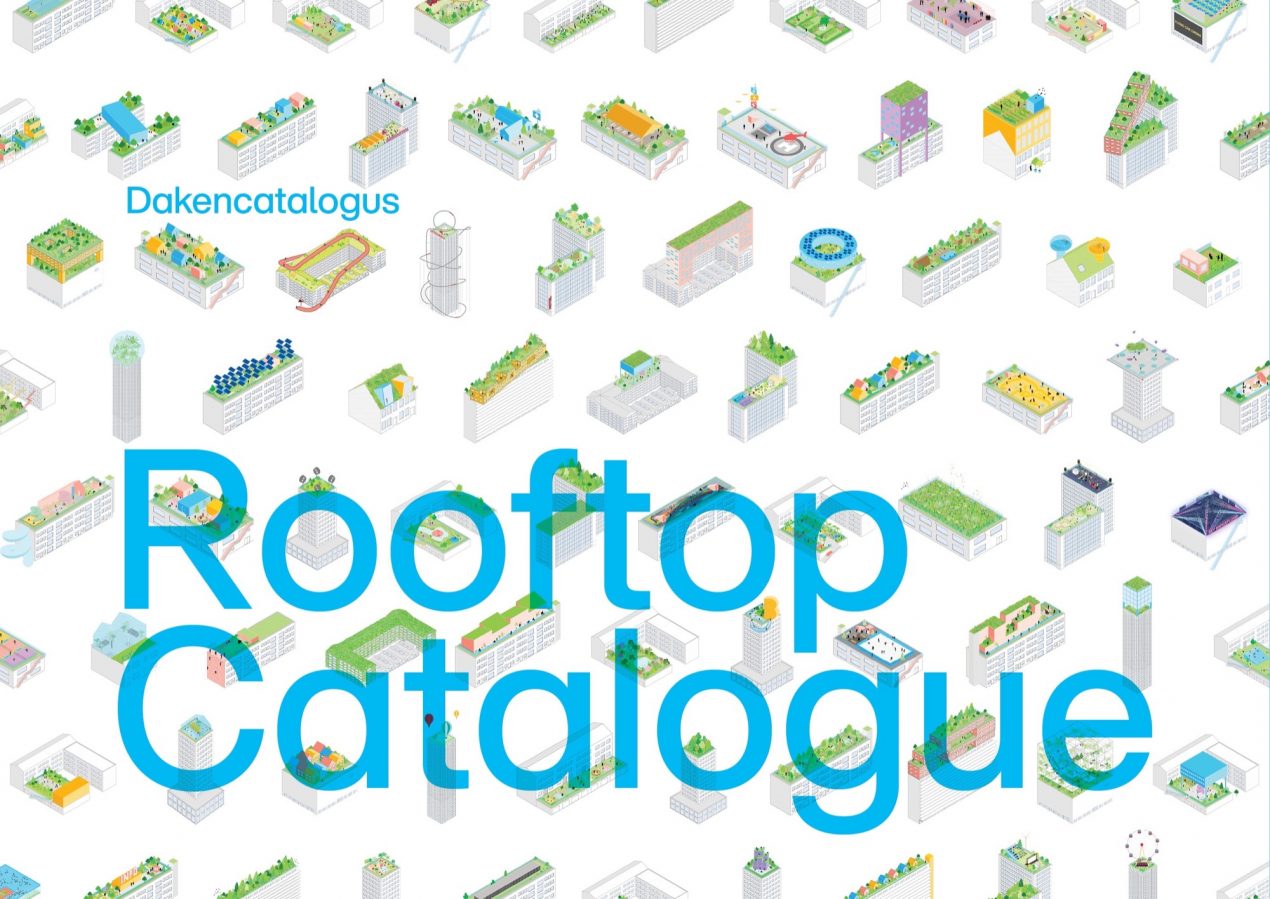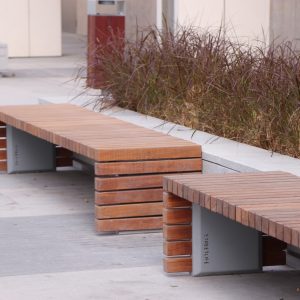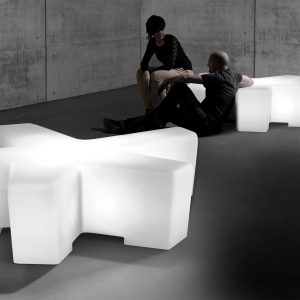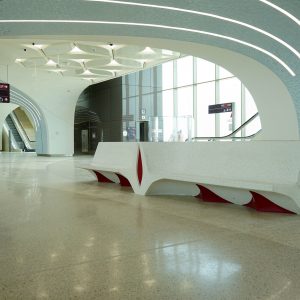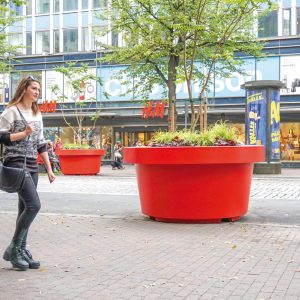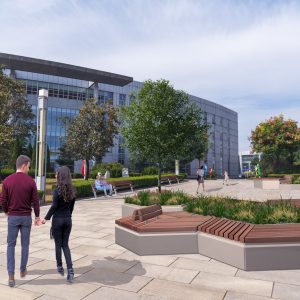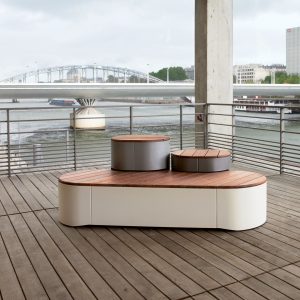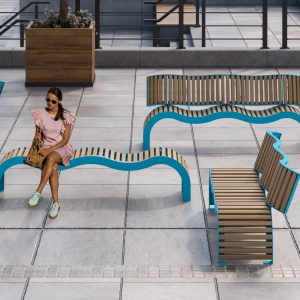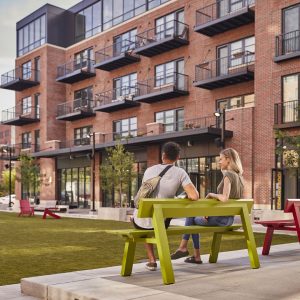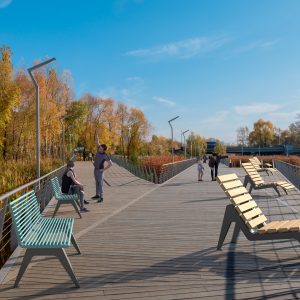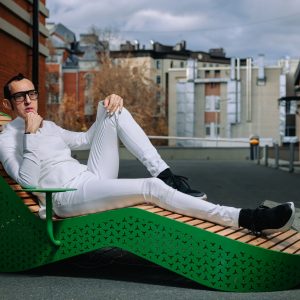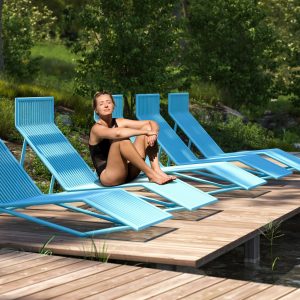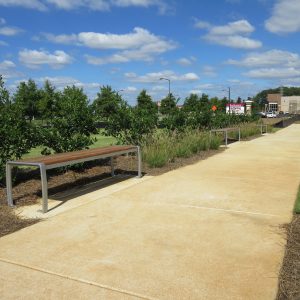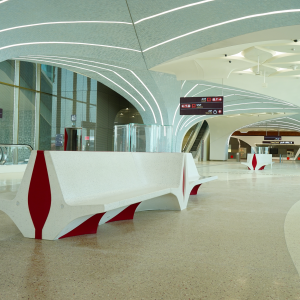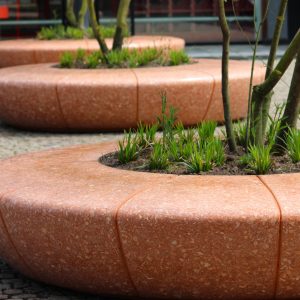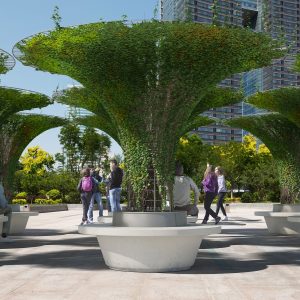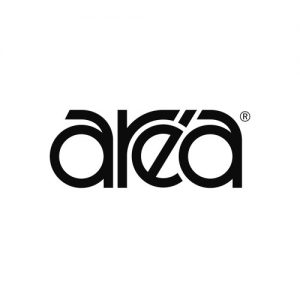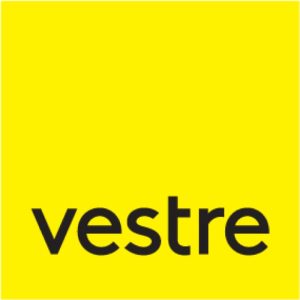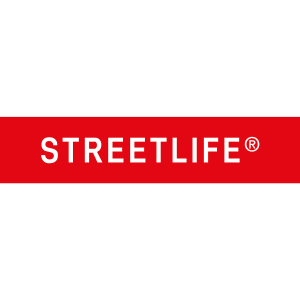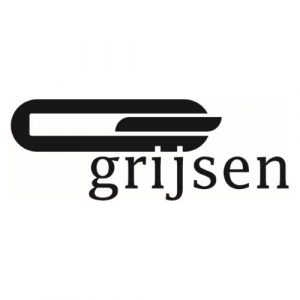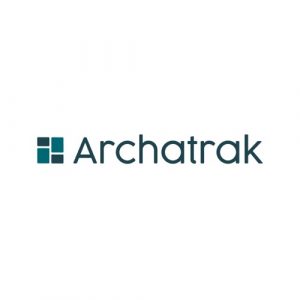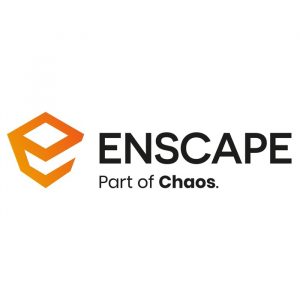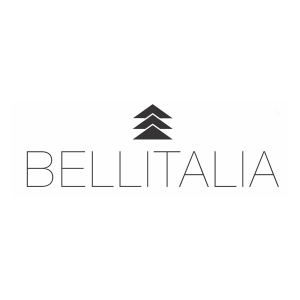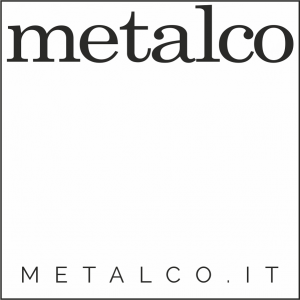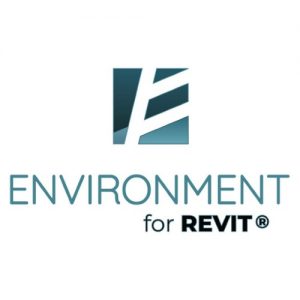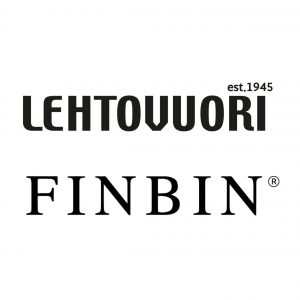Interview: Léon van Geest, Rotterdam Rooftop Days
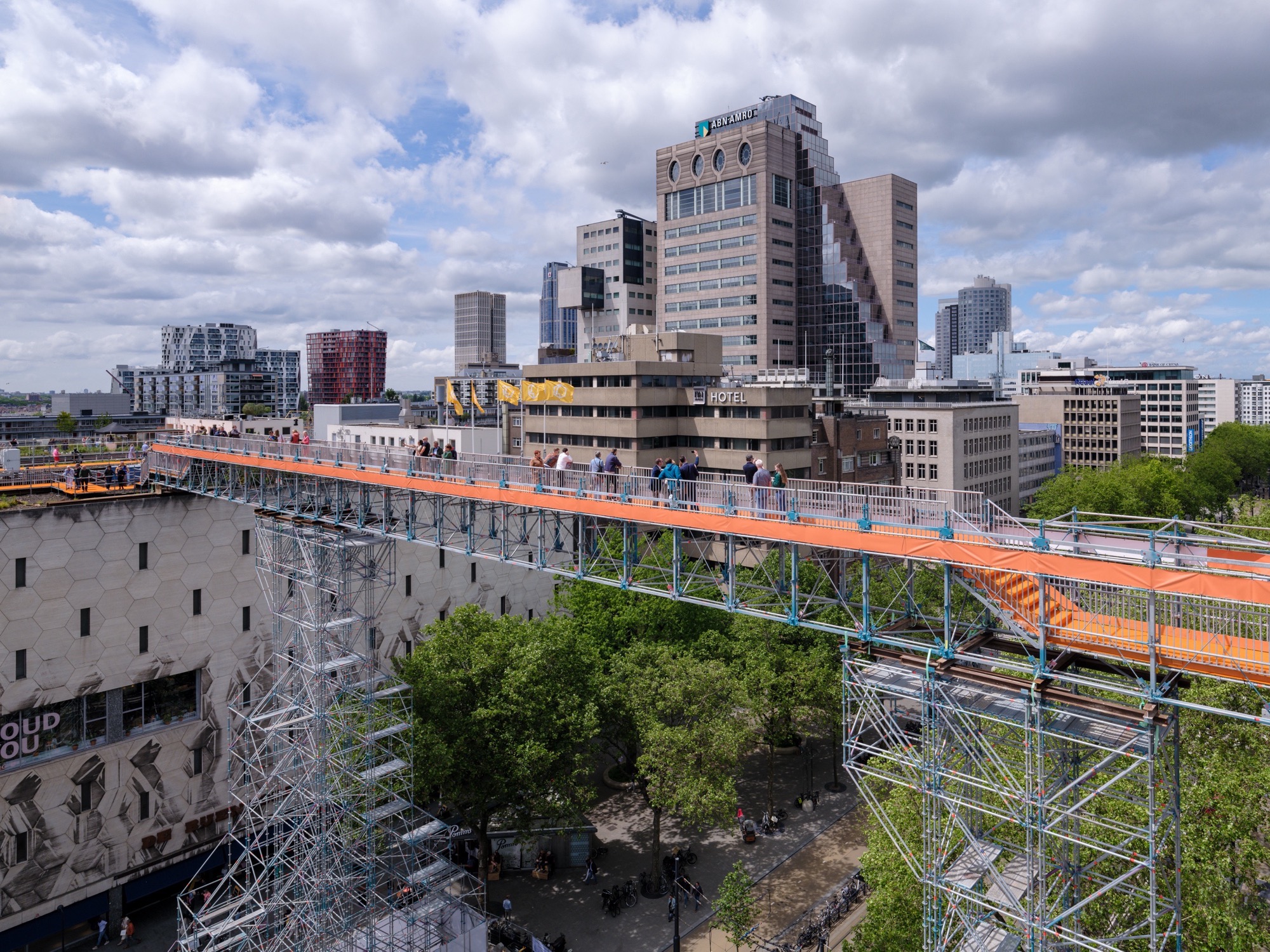
Rotterdam Rooftop Days (Rotterdamse Dakendagen) is an annual festival that promotes rooftop living and emphasises the potential of roofs in mitigating issues of public space, empowering communities, reducing urban heat, increasing urban biodiversity, urban food production etc. It features Knowledge Day, Rotterdam Rooftop Walk, various cultural events and, most importantly, establishes a network of permanently or temporarily publicly accessible roofs around Rotterdam. We were talking to Léon van Geest who co-founded the RRD in 2014 and is now co-director together with Nikki Kamps.
- Léon van Geest, photo Fred Ernst
The first question is the question that you ask people you interview: What is your first experience with roofs?
Well, there are two answers to that. And one is that as a child, I had this small roof in front of my house, which was the roof of the shed next to our house. And it included gravel and a little bit of vegetation. And it was just my view. So it did not add to anything. But it was a roof I was looking at every day. I realised that way later.
But the first time I experienced a nice rooftop was in Marseilles in the Cite Radieuse, on a rooftop of a Le Corbusier building. I am educated as an industrial designer, not an architect, and I was just stunned by what I saw there; someone made a landscape out of concrete on a rooftop. So interesting! It was all new for me, but it was also just an isolated event. Only some 20 years later would I realise the potential of roofs.
- Image: Le Corbusier, Cité Radieuse roof, photo: Marseilles Tourisme
You come from Rotterdam, which is, without a doubt, a very experimental city. There was a lot of courage in terms of urbanism and architecture, given that most parts of the city had to be rebuilt after WW2. So do you see Rooftop Days embody this experimental approach embedded in genius loci?
So Rotterdam changed a lot. It used to be a city like Amsterdam with many canals and small houses, which were bombed during WW2. And I think that since we are a harbour city, a working city, we got to our experiment and to rebuild it in an innovative and fast way.
But in the early 2000s, Rotterdam wasn’t a nice city, at least not in the perception of people from the outside. Nobody did go to Rotterdam for pleasure. They came for work. At that time, my friend and I started with guided tours, and people asked, »Okay, but what are you going to show in Rotterdam? It’s just a shitty grey, windy city.«
We did a lot of experimental tours, and in 2013 someone in charge of a music festival came to me, wanting a nice, strange tour. And another friend and I said, okay, let’s do tours on rooftops.
So then we did a few music festivals and afterwards rooftop tours. We had bands playing in elevators, going up to the rooftop, of course. We had beers on the rooftop, performances, and poetry readings. We called it ‘Poems from a rooftop’. And after that, we did some other tours over rooftops.
That was when it all started. Shortly after, we would make it a festival. And then, I stopped with the guiding tour activities, and we got together and started the Rotterdam rooftop days in 2014.
- Poems from a Rooftop, flyer
At first, we were only talking about use, how it’s a pity that so many roofs are not being used. The gravity of the potential for urban biodiversity, cooling, or water retention was initially not in our focus.
It felt as if I had fallen into a pot of gold. You had all this unused land in the city where there’s densification, and we need space, and we can use it for all these current challenges we face in the world. And we’re not going to solve them by rooftops, but they can add to the solution. The rooftops are such a nice space. But of course, we didn’t want to make an architecture festival.
We always say we are an architecture festival in sheep’s clothing because we like to show the rooftops as amenities to the general audience and not by giving them beers but by making roofs accessible. People are usually very keen about going up on the roof. Once they are there, they’re even more astounded.
And then you can tell them about all the durability, sustainability, and things that you can do there, and they get excited about the potential with you.
- Rooftop days, 2015, photo Frank Hanswijk
Yes, and rooftops have a reflective quality to them. They offer the ‘big picture, which provokes big thoughts; questions of urbanisation come to mind immediately, how we inhabit the world etc.
It does, indeed. And it’s also, of course, because you’re a bit higher, other people appear smaller. So you have this kind of overview of the city, and when you see it, you feel more involved. And I think that that’s very important.
But why do you start reflecting on a rooftop? Why is that?
We are still looking for a neurologist or someone who really knows about what happens to your brain when you go up to a rooftop. What is that feeling of freedom of overview? One of the nicest things I heard was someone say, well, the main thing is that when you’re up on a rooftop, you get the horizon back.
So when you’re in a city, you lack horizon, and then suddenly you get the horizon back. So you get the freedom in your mind to wonder about the things you would like to think about. And that whole horizon thing is a theme I like very much.
During our last Rotterdam Rooftop Days Knowledge Day, we had some people trying to grasp that roof feeling and what it is and also, could you define it scientifically? I like the term »Hoehenrausch«, a German word meaning high-altitude euphoria, a certain excitement with a scent of fear. Something very nice and something very fearful. And that’s that gold rush. Rush and joy with a little bit of adrenaline.
- DakAkker, ©Frank Hanswijk
- Dakmoestuin Rooftop Walk ©Frank Hanswijk
- Thornico Kassen ©Frank Hanswijk
If we say that roofs are an important part of solutions for more livable and green cities, hence an important part of our future, how do you see accessibility to the roofs, knowing that most buildings are private? How to steer the dynamics of private vs public, rich vs poor, when it comes to accessible roofs?
This is an important question. It is horrible to imagine a dystopian image of upper-class people living with their horizon and the sun on the top and all the rest living in the shadows on the ground level.
The place I really like is the most archetypical public space in my view, the Victorian parks in Paris. They are nice parks, and they are publicly accessible. But most of them are closed at night, and there’s a fence around them. And the fact that there’s a fence around it does not bother us. We think it’s normal that such a nice park would have a fence around it. So it could be very normal that you have a rooftop which has an entry or a door or a fence around it. Many people will say that it is not really a public space, but roofs are challenging in terms of security, police and emergency access etc.
I think cities should invest more in roofs. And some already do. Some already give subsidies for green roofs, solar panels and things like that. But you could also think in that way about creating more public space. What if a private building owner provided the city centre with a green space or sports park for the citizens? Maybe the municipality could lease that space?
It would be a really nice question to think about that because it actually improves the quality of your inner city. Of course, not every roof will or should be public, but we really should look for opportunities for public space on roofs.
- RRD 2016: Stairs to Kriterion, designed by MVRDV, photo: Ossip van Duivenbode
- RRD 2016: Stairs to Kriterion, designed by MVRDV, photo: Ossip van Duivenbode
- RRD 2016: Stairs to Kriterion, designed by MVRDV, photo: Ossip van Duivenbode
The most important thing, of course, is access to the rooftop. Winy Maas (partner at MVRDV), in 2016, designed big stairs in Rotterdam in front of the central station. Almost 400,000 people did go up the stairs because they were easily accessible, and everybody felt free to go up the rooftop. Today the rooftop is still there, and nobody uses it because it is not easily accessible, and the owner does not invest in that.
If there’s no entrance to speak of, nobody will use it. You need that connection obvious in order to make it inclusive. In the city, we need all the connections to be really clearly readable.
I’m sure you’re aware of POPS, a privately owned public space in the US. Do you think there’s a similar opportunity for roofs, also in Europe?
Yes, there are similar opportunities. And POPS, of course, already exist in Europe. The main question with POPS always is; what is the program, and how do both parties then benefit?
All around Europe, there are many 60s, 70s and 80s residential projects. Times have changed since then, and a lot of this open community space is now dominated by cars and parking lots. Can roofs help mitigate this issue?
To some extent, for sure, they can. In Copenhagen, you have this park-and-play rooftop which I think is a good example. Again they’ve made these really nice stairs attached to the facade of the parking garage where anyone can go up there to access a large roof playground, and it seems to be working really well. So I think it can help. The big danger, however, is by moving activities to rooftops, we are giving cars the freedom we want. That’s the wrong way around. We should diminish the car domination on ground level first, and then secondly, we can add nice green spaces on rooftops.
Parking House + Konditaget Lüders, JAJA Architects
Because lockdowns have sped up the shift to online shopping, retail is continuing to shrink and moving to the ground floor. That’s why we have yet to see some retail space become available. So in many places, the top floors are doing nothing anymore.
And there’s the Herleen Rooftop project by a Dutch architecture firm TOMDAVID, who, in one of their refurbishment projects, proposed that the roof, the top layer, was cut off, so the previous floors of the top floor would become the new roof. This way, the new roof would be structurally fitter to carry the programme, and it would actually be accessible via elevator and would have other necessary infrastructure.
- The Heerlen Rooftop, TOMDAVID Architecten, 2020
But old buildings aren’t always fit to accept visitors, let alone heavy substrate with trees, due to poor structural conditions. Are there any practical solutions to mitigate these technical yet essential challenges?
Well, you need a clever engineer who is willing to work with you because engineers tend to be on the very, very safe side. And there are a lot of things possible that are still safe because everybody always wants to be safe.
One of our most famous rooftops in Rotterdam is the Dakakker, a.k.a. the rooftop farm. And that is an old school building which is not reinforced at all. And there’s a whole rooftop farm on it because they concentrated all the weight on the I, which is the strongest part.
- Dakakker / Rooftop farm, ©Frank Hanswijk
And also, in the middle, where you have the columns, there is where they did the thickest layer. They used the structurally weakest part of the roof for the paths and layers that would not absorb much water and become heavy. So they made this whole structure of the garden based on the structure of the building below, which makes it even more interesting, namely, having this strangely divided landscape in height and consequently the vegetation.
And in Rotterdam, we have the newly built Erasmus Hospital in the city centre, and they’ve done a roof garden with 38 fruit trees standing in a garden where you can go up as a patient, even with a hospital bed, you can go into that garden, and it’s terrific. But all the trees are standing on top of the columns of the structure of the building.
- Erasmus Hospital, photo Léon van Geest
Approximately 70% of the old buildings will still be there in 30 years. We should think about how we can reinforce old buildings cleverly.
There is a shopping area in the heart of Rotterdam centre, which is a national monument. It’s called the Lijnbaan. It was the first shopping street without cars, but it was built so poorly. And so we now have this big discussion also with the Monuments Commission, which says we can not do anything with i’ because it’s a monument. And we are trying to convince them that we should make it ready for the future because the monument is not the building but the fact that it was an innovative shopping area. We would need to lay a structure on top to make it good for the vegetation, people, and biodiversity.
For 2023 you are again preparing Rooftop Days. Are there any details about what you will offer and which direction you will go in the next edition?
Because of COVID, we couldn’t do the Rooftop Days properly for some time now. We wish for the next edition to be as much as we can do. We will have the Knowledge Days, the tours and routes over rooftops, and we hope more developers and property owners will join in with their rooftops; they are an essential part of the rooftop movement.
There is a rather large shopping mall in the south, a not-so-good looked-after area of Rotterdam. It features a roof that is six football fields big, so we wish to show the people how the community can use this landscape. So that’s our next specific goal.
Oh, and also this winter, we’ve done an Ice skating rink on top of the biggest department store in the city, with whom we also worked for the Rooftop Walk. And this was on their initiative!
- Ice skating Bijenkorf Rotterdam, photo Kirsten van Santen
So perhaps some of our followers will be inspired by your work and would like to try to start a similar movement in their city. What advice would you give them on how to start?
We really like to explore the rooftops that aren’t developed yet. So of course we take, I think from the 60 rooftops included in our programme, there are only five rooftops which are now beautiful rooftops. We like to go to those empty spaces, and we do a small installation, invite poets there or some design installations, or we simply show a design for the rooftop and say, this could be here.
Just let people think about what that space could become, and that’s our tactic. There’s a rooftop festival in Amsterdam. They will bring you mostly to roof spaces that are already really nice, which is also a great tactic. But we like to tickle the imagination and use all the creative forces of performers or creators in Rotterdam to help us transform that landscape.
I always say to other cities, because sometimes they ask me if we can do this in Utrecht or in Prague. Of course, I could never do this in Prague because I don’t know the city. So you need people who know the city and have the connections and energy to do something like that.
Don’t look at those 60 rooftops. If you want to do it, start with one rooftop and make the best out of it. Someone from Marseilles came to me last year. They were eager to try but didn’t have 60 rooftops available. So they did it with thirteen, and it went well.
In Rotterdam, we are a working city. So we say, don’t talk about it, just do it. Don’t go making big plans or big dreams; just open up a rooftop. If you will start small, start with one small party or dinner and make it bigger next time. Just start inhabiting rooftop spaces.
For your event, you work with the well-known Dutch architectural firm MVRDV. How does that work?
MVRDV had already designed a lot of buildings where roofs are, in terms of the whole idea, a critical element, an important moment. So we already had an idea of connecting rooftops, and because they are so experienced in this field, and Winy Maas likes to think big, they were a really good partner in this organisation in conceptualising. And that’s how the rooftop walk came to be on such a scale. But then, when you have the idea, you still need to realise the idea, and there’s proof of the pudding. And that’s what we did with the great team of the Rotterdam Rooftop Days Organisation.
- HNI, The Podium 2022, designed by MVRDV, photo ©Ossip van Duivenbode
- HNI, The Podium 2022, designed by MVRDV, photo ©Ossip van Duivenbode
- HNI, The Podium 2022, designed by MVRDV, photo ©Ossip van Duivenbode
- HNI, The Podium 2022, designed by MVRDV, photo ©Ossip van Duivenbode
- Rotterdam Rooftop Walk 2022, photo ©Ossip van Duivenbode
- Rotterdam Rooftop Walk 2022, photo ©Ossip van Duivenbode
- Rotterdam Rooftop Walk 2022, photo ©Ossip van Duivenbode
- Rotterdam Rooftop Walk 2022, photo ©Ossip van Duivenbode
- Rotterdam Rooftop Walk 2022, photo ©Ossip van Duivenbode
Of course, MVRDV also did a lot of research on roof living; we published their Rooftop Catalogue, where there are more than 130 different typologies and roof schemes presented.
Besides MVRDV, we also collaborated with LOLA landscape architects. They helped us think about how to present roofs as landscapes or, better, how to have a landscape experience on a roof. It turns out you can do a lot with small interventions here and there.
So see you in Rotterdam for the next edition! Do you have the 2023 dates yet?
Our Knowledge day will be going on on June 2nd. The Whole festival will be from 1st to 4th of June. The Rooftop-Art-Park will hopefully be there for the whole month of June.
_
top image: Rotterdam Rooftop Walk 2022, photo ©Ossip van Duivenbode
Published on January 19, 2023



